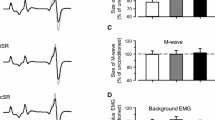Abstract.
Cutaneous reflexes in lower limb muscles were recorded from healthy human subjects after non-noxious electrical stimulation of superficial peroneal (SP), sural and distal tibial nerves while subjects: (1) made graded voluntary contractions of the ankle and knee extensor and flexor muscles while mimicking late stance or heel strike limb positions; and (2) walked on a treadmill at speeds of 2 and 4 km/h. During standing, net reflexes were predominantly suppressive and graded with background EMG. In contrast, during walking net reflexes were mostly facilitatory and uncorrelated with background EMG. Opposite signs (negative during standing, positive during walking) and significant differences of the reflex ratio (net reflex/background EMG) were seen in most leg muscles. The nerve stimulated did not determine the sign of the net reflex while standing: nerve specificity was absent. We suggest that during standing, where maintenance of posture is of primary importance, there is a reduction of effort that led to increased cutaneous input (i.e., a global suppressive response), while during walking there is a modulation of reflexes which is independent of muscle activation level but closely tied to events occurring in the step cycle.
Similar content being viewed by others
Author information
Authors and Affiliations
Additional information
Electronic Publication
Rights and permissions
About this article
Cite this article
Komiyama, T., Zehr, E. & Stein, R. Absence of nerve specificity in human cutaneous reflexes during standing. Exp Brain Res 133, 267–272 (2000). https://doi.org/10.1007/s002210000411
Received:
Accepted:
Issue Date:
DOI: https://doi.org/10.1007/s002210000411




